Small overlap front: driver-side
Rating applies to 2014-15 models
Tested vehicle: 2014 Mazda 6i Touring 4-door
The Mazda 6 was redesigned for the 2014 model year.
| Evaluation criteria | Rating |
|---|---|
| Structure and safety cage | |
| Driver injury measures | |
| Head/neck | |
| Chest | |
| Hip/thigh | |
| Lower leg/foot | |
|
Driver restraints and dummy kinematics
The dummy’s head remained in contact with the frontal airbag, but its head still moved toward the left side of the steering wheel and A-pillar because the seat belt allowed excessive forward excursion of the head and torso. The side curtain airbag deployed and had sufficient forward coverage to protect the head from contact with side structure and outside objects. The side torso airbag also deployed. | |
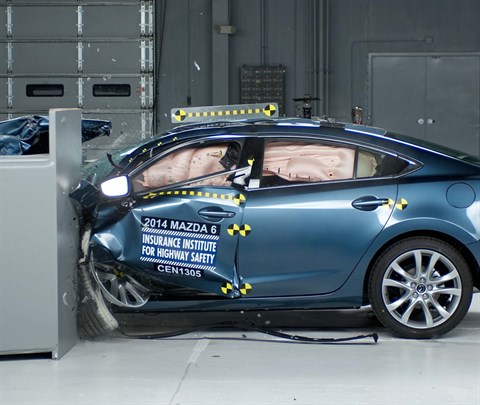
Action shot taken during the driver-side small overlap frontal crash test.
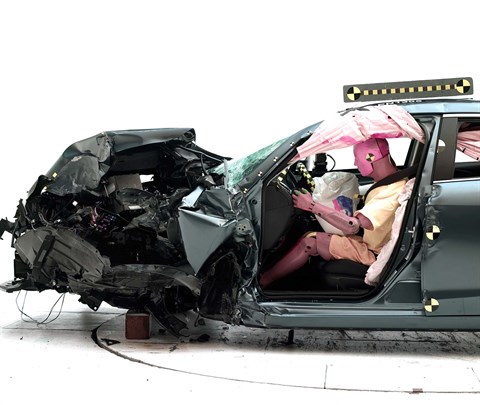
The dummy's position in relation to the door frame, steering wheel, and instrument panel after the crash test indicates that the driver's survival space was maintained reasonably well.
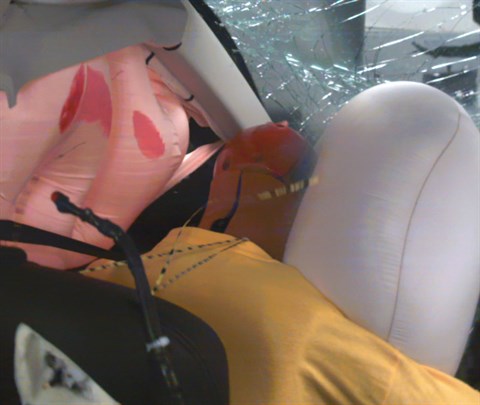
The seat belt allowed far too much forward movement of the dummy to the extent that its head hit the steering wheel hard through the airbag.
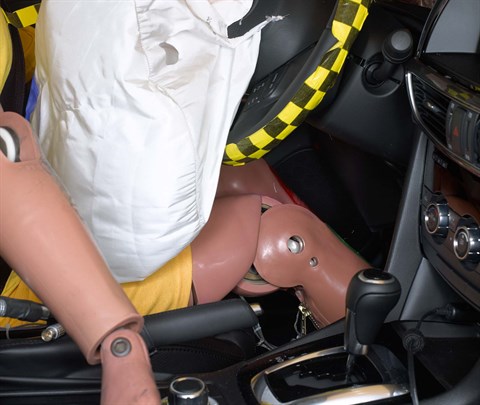
Forces on the right lower leg were just high enough to indicate a moderate risk of injury.
Moderate overlap front: original test
Rating applies to 2014-21 models
Tested vehicle: 2014 Mazda 6i Touring 4-door
The Mazda 6 was redesigned for the 2014 model year. Two moderate overlap frontal tests of the Mazda 6 were conducted, one by the Institute and the other by Mazda. Ratings are based on both tests.
| Evaluation criteria | Rating |
|---|---|
| Overall evaluation | |
| Structure and safety cage | |
| Driver injury measures | |
| Head/neck | |
| Chest | |
| Leg/foot, left | |
| Leg/foot, right | |
| Driver restraints and dummy kinematics | |

Action shot taken during the Institute's moderate overlap frontal crash test.
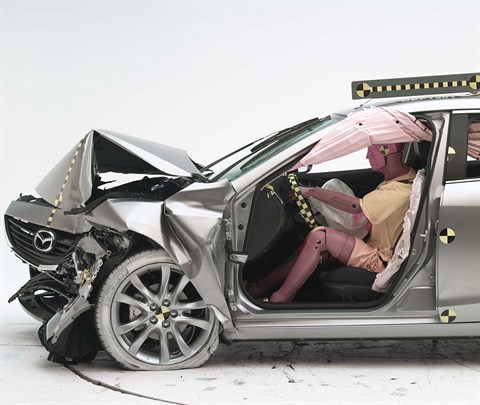
The dummy's position in relation to the steering wheel and instrument panel after the crash test indicates that the driver's survival space was maintained very well (Institute test car shown).
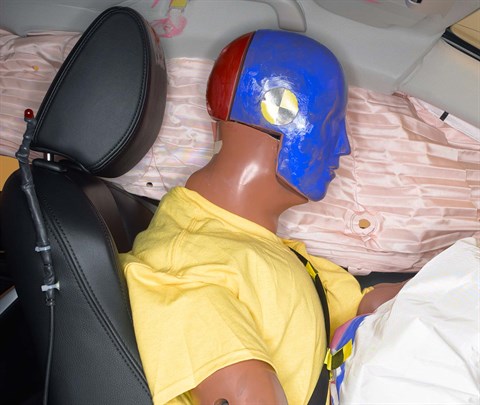
Dummy movement was well controlled in both tests. During rebound in the Institute's test, the dummy's head hit the sunvisor, roof, and grab handle, as indicated by smeared pink greasepaint.
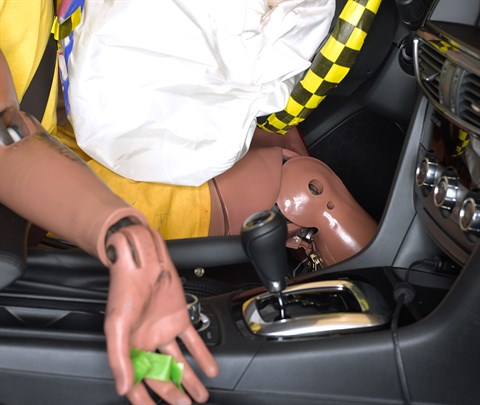
Intrusion into the driver's space was minimal in both tests. In Mazda's test, all leg and foot injury measures were low. In the Institute's test, forces on the right lower leg were just high enough to indicate the possibility of injuries.
Side: original test
Rating applies to 2014-21 models
Tested vehicle: 2014 Mazda 6i Touring 4-door with standard front and rear head curtain airbags and standard front seat-mounted torso airbags
The Mazda 6 was redesigned for the 2014 model year. Side ratings are assigned by the Institute based on a test conducted by Mazda.
| Evaluation criteria | Rating |
|---|---|
| Overall evaluation | |
| Structure and safety cage | |
| Driver injury measures | |
| Head/neck | |
| Torso | |
| Pelvis/leg | |
| Driver head protection | |
| Rear passenger injury measures | |
| Head/neck | |
| Torso | |
| Pelvis/leg | |
| Rear passenger head protection | |
Roof strength
Rating applies to 2014-21 models
Tested vehicle: 2014 Mazda 6i Touring 4-door
| Overall evaluation | |
|---|---|
| Curb weight | 3,217 lbs |
| Peak force | 16,776 lbs |
| Strength-to-weight ratio | 5.21 |
Head restraints & seats
Seat type: Leather power seat
| Overall evaluation | |
|---|---|
| Dynamic rating | |
| Seat/head restraint geometry |
About the head restraint & seat test
Currently, IIHS tests apply only to front seats.
Front crash prevention: vehicle-to-vehicle
Ratings are given for 2 different trim variations available on this vehicle.
Child seat anchors
Rating applies to 2015 models
| Evaluation criteria | Rating |
|---|---|
| Overall evaluation | |
| Vehicle trim | i Sport |
| Seat type | cloth |
This vehicle has 2 rear seating positions with complete child seat attachment (LATCH) hardware.
It has 1 additional seating position with a tether anchor and the ability to borrow lower anchors from the other seating positions.
Note: When anchors are borrowed, they aren't available to use in their designated positions.
| Evaluation criteria | Rating |
|---|---|
| Overall evaluation | |
| Vehicle trim | i Sport |
| Seat type | cloth |
| Rating icon | Rating |
|---|---|
| G | Good |
| A | Acceptable |
| M | Marginal |
| P | Poor |
| Seating positions that rely on borrowed lower anchors or have only a tether anchor available are not rated. | |
thether anchor symbol | Tether anchor |
lower anchor symbol | Lower anchors |
| Lower anchor(s) can be borrowed from adjacent positions(s) | |
| No hardware available |
Details by seating position
| Position | Rating |
|---|---|
| 1 | |
| Tether anchor | |
| easy-to-find location | |
| no other hardware could be confused for anchor | |
| Lower anchors | |
| too deep in seat | |
| too much force needed to attach | |
| easy to maneuver around anchors | |
| 2 | |
| Tether anchor | |
| easy-to-find location | |
| no other hardware could be confused for anchor | |
| Lower anchors | |
| Can be borrowed from 1 and 3 | |
| 3 | |
| Tether anchor | |
| easy-to-find location | |
| no other hardware could be confused for anchor | |
| Lower anchors | |
| too deep in seat | |
| too much force needed to attach | |
| difficult to maneuver around anchors |
